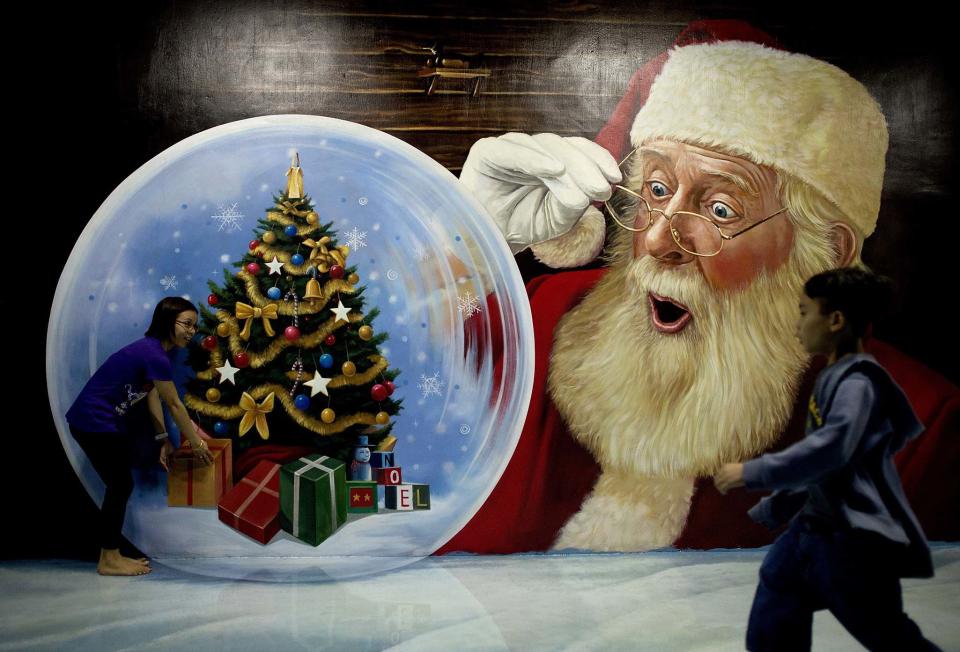Why does Santa look the way he looks? How his image went from Elvis Presley to today's look
- Oops!Something went wrong.Please try again later.
- Oops!Something went wrong.Please try again later.
With his red suit, big belly and jolly beard, Santa Claus' image has been associated with the Christmas season for decades.
But he didn't always look like how you might picture him today, as his depiction has gone through several changes over centuries. In fact, he at one point looked a lot like a famous rock singer, according to Steve Wilkens, theology and ethics professor at Azusa Pacific University in California. It wasn't until the 20th century when we got the Santa Claus we see today.
"You have this transformation to the young Elvis skinny, to the old Elvis, then chubby Santa Claus," Wilkens told USA TODAY, adding the Santa Claus we all know today is "modern invention."
So how did Santa Claus end up looking like how he does now?
Why we kiss underneath a parasite: The origins of mistletoe, explained
Are Christmas lights jacking up your electric bill? Big displays could cost you hundreds

The origin of Santa Claus
In order to understand Santa Claus' appearance today, you have to go back to the year 260 A.D., when the origin of Santa, Saint Nicholas, was born in present day Turkey.
Nicholas came from wealth, Wilkens said, and when his parents died when he was young, he decided to be charitable with his inheritance. Nicholas was praised for throwing gold into the home of a man who had lost his money and was going to offer his daughters for prostitution, according to an excerpt from "The Oxford Handbook of Christmas."
"Nicholas became quite renowned for his generosity, particularly toward the poor, and was eventually made bishop," Wilkens said.
The generosity of Saint Nicholas became so popular that Dec. 6 – the day he died – became a holiday known as Nicholas' Feast Day, which became a "grand opportunity for parades, dramatic impersonations, gift-exchanges, and family meals," according to The Oxford Handbook of Christmas. It's also this time when the earliest depictions of Nicholas are created.
"The earliest depictions do have him with a beard, but it's a rather narrow beard, and he is rather gaunt," Wilkens said.
From the USA TODAY Network: What to know about St. Nicholas Day
Saint Nicholas begins to look like Santa Claus
Saint Nicholas has been praised for centuries, but the morphing of him into Santa Claus occurred when Dutch immigrants moved to the U.S. in the 18th century, bringing along their love of Saint Nicholas. To the Dutch, he was known as Sinter Klaas, which later turned into Santa Claus.
The snowball began to role on his appearance in the 1810s when John Pintard of the New York Historical Society depicted Sinter Klaas in bishop attire, before fellow member Washington Irving created the image of the saint "equipped with a low, broad-brimmed hat, a huge pair of Flemish trunk-hose, and a pipe," according to "Christmas: A Candid History" by Bruce David Forbes.
The biggest step in Santa's appearance came in the 1823 poem that became known as "'Twas the night before Christmas." In the poem, here's how Santa is depicted:
"He was dressed all in fur, from his head to his foot,
And his clothes were all tarnished with ashes and soot.""His eyes -- how they twinkled! His dimples how merry!
His cheeks were like roses, his nose like a cherry!""He had a broad face and a little round belly, that shook when he laughed, like a bowlful of jelly. He was chubby and plump, a right jolly old elf.
"That poem was deeply, deeply influential," Wilkens said.
What's the best Christmas cookie? Google shares popular holiday searches by state
With the help of Coca-Cola, Santa Claus picture is complete
If "'Twas the night before Christmas" created the Santa image, Thomas Nast – the German illustrator who created Republican elephant and the Democratic donkey – brought it to life with his drawings in "Harper's Weekly." Forbes describes Nast's drawings as "a little different from our modern image" with a fur hat and clothes "that looked like very itchy long underwear."
The final piece of the puzzle was with the help of Coca-Cola. Artist Haddon Sundblom was commissioned by the soda company to draw Santa, and it was him in 1931 who painted the figure in his iconic red suit we see today, and we may continue to see for a long time.
"I'm always nervous about predicting out into the future," Wilkens said about the future look of Santa. "We've got about 100 years now and Santa looks pretty much like the old 1931 Coca-Cola Santa."
Follow Jordan Mendoza on Twitter: @jordan_mendoza5.
This article originally appeared on USA TODAY: What does Santa Claus look like? Explaining origin of red suit, beard

